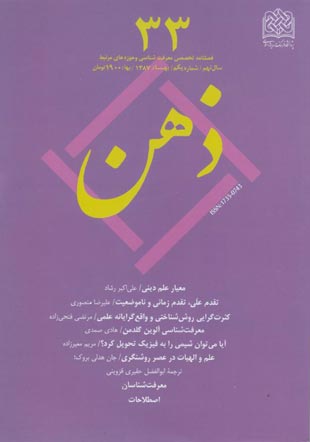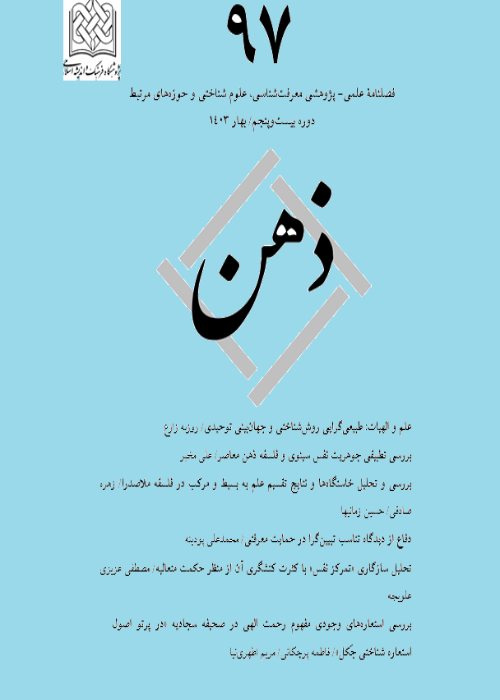فهرست مطالب

فصلنامه ذهن
سال نهم شماره 1 (پیاپی 33، بهار 1388)
- 176 صفحه، بهای روی جلد: 19,000ريال
- تاریخ انتشار: 1386/11/08
- تعداد عناوین: 8
-
صفحه 5
-
صفحه 13
-
صفحه 101
-
صفحه 133
-
صفحه 141
-
Page 5The esteemed author has divided criteria for religious science into two groups: "intrinsic-internal", "extrinsic-external"; and for each of them, he has enlisted some kinds; he thinks that applying the term "religious science" to "scientific systems" is, depending on the kind and extent of criteria obtained in science, a multi-leveled and gradual process. Also, he thinks that if propositions result from authenticate religious sources and through employing religious justified logic, then they may be regarded as religious ones.Keywords: religious science, secular science, philosophy of religious science, philosophy of religious knowledge, criterion for religious science, science of religions, science of bodies (natural science)
-
Page 13Along with Bell theorem, Stapp has argued for non-local causal impacts. In the present article, while analyzing Stapp's argument, the author aims to study cause-and-effect priority in the light of non-local quantum interrelations, and find that, if we take special relativity into account, how quantum non-locality may impact our understanding of causality and causal priority.Keywords: causal priority, temporal succession, quantum interrelation, bell theorm, non, locality, superlight impact
-
Page 29Scientific rationality is in a close relation to scientific methodology. Theories concerning scientific methodology are divided into monist and pluralist ones. Methodologists and empiricist philosophers of science advocate monist theories. On the other hand some modern philosophers of science support scientific pluralist and un-realist methodology. This diversity of views to the nature of methodology and realist or un-realist goal of the science has resonated current debates concerning scientific rationality. Howard Sankey tries to find an inclusive theory concerning scientific rationality through combining some components of traditional and modern views to the nature of methodology. The present essay introduces and analyzes this theory.Keywords: scientific rationality, scientific realism, pluralist methodology, Howard Sankey
-
Page 73The American philosopher, Alvin Goldman, was born in 1938. Currently he is a professor of philosophy in Rutgers University in the US. Most of his philosophical works are in the fields of "action theory", epistemology, philosophy of mind, and cognitive sciences. In the contemporary epistemology, Goldman is an eminent figure of whom we hear repeatedly in discussions concerning justification, causal theory of knowledge, reliablism, social epistemology, and scientific epistemology. This article is an overview of some of Goldman's ideas in the field of contemporary epistemology.
-
Page 85Physicalists think that all facts of the universe may be explained in terms of physical realities. In other words, a physicalist has (to know) and be able (how) to put all various kinds of equivalent approaches in the scope of reductionism. Reductionists claim for an extensive spectrum of ontological and epistemological ideas. In the field of reductionism, reduction of chemistry into physics is mostly spoken of. Reductionist physicalists claim that they are able, by employing relativistic and non-relativistic quantum mechanics, to calculate energies of atoms. In the present article, the author has tried to provide an overview of reductionism and its patterns and versions, and thus to show weakness of this claim in the field of reduction of chemistry into physics.Keywords: reductionism, patterns of reduction, reduction of chemistry into physics, weakness of ontological reduction, weakness of epistemological reduction
-
Page 101In this article, John Hedley Brooke offers an introduction and critical guide to one of the most fascinating and enduring issues in the development of the modern world: the relationship between scientificthought and religious belief. It is common knowledge that in western societies there have been periods of crisis when new science has threatened established authority. The trial of Galileo in 1633 and the uproar caused by Darwin’s Origin of Species (1859) are two of the mostfamous examples. Taking account of recent scholarship in the history of science, Brooke takes a fresh look at these and similar episodes, showing that science and religion have been mutually relevant in so rich a variety of ways that no simple generalizations are possible. A special feature of the article is that Brooke stands back from general theses affirming ‘conflict’ or harmony’, which have so often served partisan interests. His object is to reveal the subtlety, complexity, and diversity of the interaction as it has taken place in the past and in the twentieth century. Instead of treating science and religion as discreet definable entitles, a historical approach requires sensitivity to shifting boundaries and a willingness to consider the contexts in which particular forms of ‘science’ could be used for both religious and secular ends.


